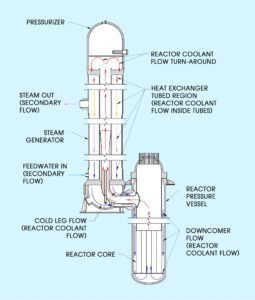Nuclear Advisory Council Deems Commissioning of Holtec SMR-160 by 2030 a 'Credible Target'
Holtec International’s ambitions to install its first set of SMR-160 small modular reactor nuclear plants in the U.S. by 2030 may be a “credible target,” the company’s advisory council comprising 20 utility and nuclear industry leaders has reportedly determined.
The Holtec Advisory Council, a body that provides Holtec with “input on the technical and commercial merits and weaknesses” of its SMR-160 program, made the assessment during a bi-annual meeting on Sept. 14, Holtec told POWER. The council comprises nuclear technology and strategy executives from Entergy Nuclear, American Electric Power, Energy Harbor, Duke Energy, Exelon, Bruce Power, Ontario Power Generation, and several consultant groups, it said. “Having considered Holtec’s progress, the Council viewed Holtec’s hard date for commissioning its first set of SMR-160 plants in the U.S. by 2030 as a credible target,” it said.
The ambitious schedule to put Holtec’s first 160-MW advanced light water reactors (LWR) online within the next eight years is a notable development for Holtec, a diversified energy technology company that has pursued the development and deployment of a small modular reactor (SMR) since 2010. The company, which also fabricates heat-exchanger and nuclear waste storage equipment, says development of a safe SMR could “re-validate its reputation as the developer of transformative technologies.”
The SMR-160 is a single loop (160-MWe, 525 MWth) natural circulation pressurized water reactor (PWR) design that includes a passive core cooling system with no need for pumps or valves. The reactor coolant system, which features an integral primary heat transfer circuit instead of the traditional multi-loop circuit of large PWRs, follows a basic philosophy to use natural circulation to promote heat transfer from the core to the steam generator, while using simple, diverse safety systems that use natural, passive phenomena for emergency core cooling.

Holtec has said that while the SMR-160 is primarily designed for power generation, it can support optional cogeneration equipment for applications such as hydrogen generation, district heating, and seawater desalination. The reactor is also capable of both black-start and island operation, making it ideal for remote or microgrid applications. It is also designed to provide flexible power output and perform load following based on grid demand.
Compared to several emerging reactor designs, an SMR-160 plant won’t need specialized fuel, it has noted. Last year, Holtec picked Framatome to supply standardized PWR fuel to the SMR-160 through its commercially available 17 x 17 GAIA fuel assembly. As significantly, “the plant design incorporates a spent fuel management approach that accommodates the discharge of spent fuel assemblies to underground dry storage in the [Holtec] HI-STORM UMAX storage system after the second reactor refueling,” it has said.
However, where the company will site its first set of SMR-160 plants remains uncertain. In January, the company confirmed it was exploring a potential project at Holtec’s Oyster Creek site, a nuclear power plant site that housed a 619-MW boiling water reactor for decades until it closed in 2018. In August, the company reported all fissile material in Oyster Creek’s reactor building has now been transferred to the on-site independent spent fuel storage installation. “The Reactor Building is now devoid of any fissile material. The Protected Area at the site has been reduced from approximately 150 acres to 6 acres with the [Nuclear Regulatory Commission’s (NRC’s)] authorization, making the task of the security workforce substantially easier and a more concentrated effort,” it said.
Holtec is also still currently conducting pre-licensing activities for the SMR-160 design with the NRC. Last December, the company submitted the first of five planned topical reports to the commission to support the innate safety case for the reactor design. In 2020, notably, it also completed Phase 1 of the Canadian Nuclear Safety Commission “Pre-Licensing Review of a Vendor’s Reactor Design.”
Its funding approaches, including for the design’s development and for future projects, also remain unclear. Holtec on Wednesday said it had informed its advisory council that the company is “in talks with the [Department of Energy (DOE)] for partial financing of its advanced reactor program.” It is unclear whether those discussions relate to a December 2020–granted DOE award valued at $147.5 million (DOE share is $116 million with Holtec’s investment share being $31.5 million) under the agency’s risk reduction awards. Holtec estimates it has invested $400 million on the SMR-160 program.
Development efforts are ongoing at the company’s 50-acre, $260 million technology campus on the Delaware River in Camden, New Jersey, the company says. The facility houses a technology center, a large manufacturing facility, a reactor test loop, and several auxiliary buildings to support the SMR-160, it says.
—Sonal Patel is a POWER senior associate editor (@sonalcpatel, @POWERmagazine).